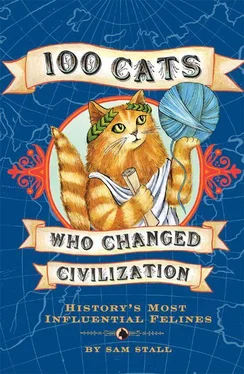SIR ISAAC NEWTON’S CAT
THE INSPIRATION FOR THE CAT DOOR

Physicist Sir Isaac Newton was one of history’s greatest mathematicians and theorists. During his lifetime he made numerous contributions to science, including developing the laws of celestial mechanics, codeveloping calculus, and conducting groundbreaking work on everything from the nature of light spectra to measurements of the speed of sound. But few realize that Newton was also a pet lover—or that sometimes his numerous animal friends could drive him to distraction. For instance, he once suffered an emotional breakdown when a favorite dog knocked over a candle on his desk, burning some of his important research notes.
His dealings with an annoying cat yielded happier results. The world’s felines (and canines, for that matter) owe an everlasting debt of gratitude to this overbearing pet, whose name is lost to history. According to legend, it constantly interrupted Newton with its demands to be let in and out of the house. Frustrated, the scientist quickly designed and implemented a solution—the pet door. Today, every feline blessed with the ability to enter and leave a room without troubling his or her human friends has Newton (and his restless charge) to thank.
TEE CEE
THE CAT WHO PREDICTED SEIZURES

Were it not for their quirky, independent personalities, cats might be naturals for all sorts of jobs usually done by service dogs. Keenly observant and alert to the slightest changes in their surroundings, felines could make wonderful guardians. So far, however, they’ve firmly rejected any such callings.
All save for one.
The cat in question is named Tee Cee, and he has earned international fame for his uncanny ability to predict epileptic seizures—a skill he’s used to ease the suffering of his grateful owner. Ironically, the English feline had endured quite a bit at the hands of a human, who stuffed Tee Cee and his littermates in a box and tossed it in a river. He was rescued and taken to an adoption center, where he became the pet of Michael Edmonds, a Sheffield man who suffers from an extremely dangerous and unpredictable form of epilepsy. The disorder causes sudden, violent seizures that strike without warning. The problem is so serious that Edmonds can’t leave home unescorted, for fear of having an attack at some unexpected time or place.
Edmonds’s new cat provided almost providential help. Tee Cee took a great deal of interest in his new owner—particularly, it seemed, when he was about to seize. This was remarkable, because Edmonds displays no symptoms prior to attacks. Or at least, none detectable by humans. “We noticed that Tee Cee began staring at my stepfather prior to a seizure and then ran to my mother to let her know all is not well, acting as an early warning system,” Edmonds’s stepdaughter, Samantha Laidler, told the BBC. “Once assistance arrives, Tee Cee doesn’t leave Michael’s side until he regains consciousness, and his warnings have proved invaluable to the family.”
The behavior was so unexpected that it took a while for family members to make the connection between Tee Cee’s staring sessions and Edmonds’s epileptic fits. But once the link was established, the fame of the former stray spread far and wide. In 2006 he was nominated for a prestigious Rescue Cat of the Year Award—quite an accomplishment for a feline who was once, literally, thrown away as garbage.
CC
THE CAT WHO WAS A CLONE

This cleverly named creature won fame for being both the most unique and un-unique of cats. Born in late 2001 in a blaze of publicity, CC (short for Copy Cat) was the world’s first cloned feline.
The mostly gray calico was the crowning achievement of a research program originally established to clone dogs. In 1997, millionaire entrepreneur John Sperling bankrolled a roughly $4 million effort to develop a replacement for his beloved mutt, Missy. After years of work on what came to be known as the Missyplicity Project, scientists at Texas A&M University learned one key fact about cloning canines: It’s hard. Cats, however, are relatively easier.
Emphasis on relatively . The group endured eighty-seven failures before producing CC. In 2000, Sperling and others founded a company to offer the process to grieving pet owners who pined for duplicates of their dearly departed friends—and could pay somewhere in the middle five figures to get them.
The birth of CC seemed to validate the business model of the company that created her. Bereaved but well-heeled former cat owners could turn to an organization whose name, Genetic Savings & Clone, sounded like something from an old Outer Limits episode. The company ramped up its program to something approaching mass production. Clients with an eye toward the future could PetBank some of their cat’s premortem DNA for future use in the Nine Lives Extravaganza cloning program. Then, when the original pet passed away, scientists at the company’s state-of-the-art Madison, Wisconsin, laboratory could use that genetic information to create an embryo to be carried by a surrogate cat mom.
Is it possible to put a price tag on such a miracle? Actually, yes. Cat owners can make a deposit in the PetBank for around $1,000, and get a copy of their kitty for roughly $32,000.
Unfortunately for the company’s backers, not enough people wanted carbon copies of their deceased kitties. Genetic Savings & Clone went out of business in late 2006. Interestingly, even though the firm trafficked in clones, it couldn’t guarantee that the cats it created would be exact copies of the originals. Nature, it seems, hates to repeat itself. Though the company’s clones carried the same genetic code as the original animals, environmental factors sometimes introduced slight—or not-so-slight—variations. For instance, while CC is an exact genetic duplicate of her DNA donor (a calico tabby named Rainbow), her fur is a different color.
ACOUSTIC KITTY
THE CAT THE CIA TURNED INTO A BUG

The mysterious world of espionage reached its pinnacle during the darkest days of the Cold War. As the Soviet Union and the West struggled for worldwide military and economic supremacy, no intelligence-gathering scheme seemed too wild or harebrained if it offered a chance, however small, of gaining vital information.
Yet, even in the context of those desperate times, the CIA’s plan to turn a stray cat into an electronic intelligence gathering platform still sounds rather, well, nuts .
The project was revealed to the public in 2001, when it was mentioned in a passel of heavily censored documents declassified by the CIA’s Science and Technology Directorate. According to experts, the scheme, hatched during the 1960s, was to wire felines with listening equipment so they could eavesdrop on conversations. The prototype, called Acoustic Kitty, was surgically implanted with microphones, batteries, and a radio receiver, along with an antenna running up its tail. The $16 million project came to an abrupt end, however, during field trials. The bionic cat was released near a park and was promptly run over by a taxi.
Читать дальше













